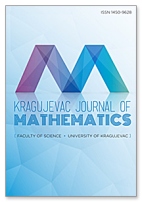An Approach to Lagrange’s Theorem in Pythagorean Fuzzy Subgroups
 Download PDF
Download PDF
Authors: S. BHUNIA AND G. GHORAI
DOI: 10.46793/KgJMat2406.893B
Abstract:
The Pythagorean fuzzy environment is a modern way of depicting uncertainty. The concept of Pythagorean fuzzy semi-level subgroups of any group is described in this paper. The Pythagorean fuzzy order of an element in a Pythagorean fuzzy subgroup is introduced and established various algebraic attributes. The relation between the Pythagorean fuzzy order of an element of a group and the order of that group is established. The Pythagorean fuzzy normalizer and Pythagorean fuzzy centralizer of Pythagorean fuzzy subgroups are discussed. Further, the concept of Pythagorean fuzzy quotient group and the index of a Pythagorean fuzzy subgroup are defined. Finally, a framework is developed for proving Lagrange’s theorem in Pythagorean fuzzy subgroups.
Keywords:
Pythagorean fuzzy set, Pythagorean fuzzy subgroup, Pythagorean fuzzy order, Pythagorean fuzzy quotient group.
References:
[1] G. M. Addis, Fuzzy homomorphism theorems on groups, Korean J. Math. 26(3) (2018), 373–385. https://doi.org/10.11568/kjm.2018.26.3.373
[2] N. Ajmal and A. S. Prajapati, Fuzzy cosets and fuzzy normal subgroups, Inf. Sci. 64(1) (1992), 17–25. https://doi.org/10.1016/0020-0255(92)90107-J
[3] N. Ajmal, Homomorphism of fuzzy groups, correspondence theorem and fuzzy quotient group, Fuzzy Sets and Systems 61(3) (1994), 329–339. https://doi.org/10.1016/0165-0114(94)90175-9
[4] K. T. Atanassov, Intuitionistic Fuzzy Sets, Fuzzy Sets and Systems 20(1) (1986), 87–96. https://doi.org/10.1016/S0165-0114(86)80034-3
[5] S. Bhunia and G. Ghorai, A new approach to fuzzy group theory using (α,β)-Pythagorean fuzzy sets, Songklanakarin Journal of Science and Technology 43(1) (2021), 295–306. https://doi.org/10.14456/sjst-psu.2021.38
[6] S. Bhunia, G. Ghorai and Q. Xin, On the characterization of Pythagorean fuzzy subgroups, AIMS Math. 6(1) (2021), 962–978. https://doi.org/10.3934/math.2021058
[7] S. Bhunia, G. Ghorai and Q. Xin, On the fuzzification of Lagrange’s theorem in (α,β)-Pythagorean fuzzy environment, AIMS Math. 6(9) (2021), 9290–9308. https://doi.org/10.3934/math.2021540
[8] R. Biswas, Fuzzy subgroups and anti-fuzzy subgroups, Fuzzy Sets and Systems 35(1) (1990), 121–124. https://doi.org/10.1016/0165-0114(90)90025-2
[9] A. B. Chakraborty and S. S. Khare, Fuzzy homomorphism and algebraic structures, Fuzzy Sets and Systems 59(2) (1993), 211–221. https://doi.org/10.1016/0165-0114(93)90201-R
[10] V. N. Dixit, R. Kumar and N. Ajmal, Level subgroups and union of fuzzy subgroups, Fuzzy Sets and Systems 37(3) (1990), 359–371. https://doi.org/10.1016/0165-0114(95)00091-7
[11] J. G. Kim, Orders of fuzzy subgroups and fuzzy p-subgroups, Fuzzy Sets and Systems 61(2) (1994), 225–230. https://doi.org/10.1016/0165-0114(94)90237-2
[12] J. N. Mordeson, K. R. Bhutani and A. Rosenfeld, Fuzzy Group Theory, Springer-Verlag, New York, 2005.
[13] X. Peng and Y. Yang, Some results for Pythagorean fuzzy sets, International Journal of Intelligent Systems 30(11) (2015), 1133–1160. https://doi.org/10.1002/int.21738
[14] A. K. Ray, On product of fuzzy subgroups, Fuzzy Sets and Systems 105(1) (1999), 181–183. https://doi.org/10.1016/S0165-0114(98)00411-4
[15] A. Rosenfeld, Fuzzy Groups, J. Math. Anal. Appl. 35(3) (1971), 512–517. https://doi.org/10.1016/0022-247X(71)90199-5
[16] R. L. Roth, A history of Lagrange’s theorem on groups, Math. Magazine 74(2) (2001), 99–108. https://doi.org/10.1080/0025570X.2001.11953045
[17] M. Tarnauceanu, Classifying fuzzy normal subgroups of finite groups, Iranian Journal of Fuzzy Systems 12(2) (2015), 107–115. https://dx.doi.org/10.22111/ijfs.2015.1986
[18] R. R. Yager, Pythagorean Fuzzy Subsets, in: Proceedings of the 9th Joint World Congress on Fuzzy Systems and NAFIPS Annual Meeting, Edmonton, AB, Canada, 2013, 57–61.
[19] L. A. Zadeh, Fuzzy sets, Information and Control 8(3) (1965), 338–353. https://doi.org/10.1016/S0019-9958(65)90241-X
